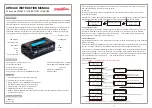
WARNING
High voltage!
If there is evidence of damage to the battery
charger, cables or connectors, switch off the
mains power. Do not touch damaged parts.
Do not touch uninsulated battery terminals,
connectors, or other live electrical parts.
Contact service personnel.
Safety shut-off
Charging is terminated if:
•
The recharged number of ampere hours
exceeds the preset value.
•
The charging time for any of the charging
phases exceeds the preset value.
•
Voltage and current exceed the maximum set
value.
•
The battery is disconnected without the
battery charger being stopped.
Charging is temporarily stopped or reduced when:
•
The battery charger temperature exceeds
charger limits.
Checking error messages
If the battery charger’s built-in self-testing function
detects a fault, this is indicated via the status
LED’s on the front panel. Red flashing LED
indicates a charging fault. Red fixed light
indicates a fault in the charger.
Please make a note of any faults and send for
authorised service personnel.
Checks
1. Check the cables and connectors for
damages.
2. Check that the battery is free from defects, in
good condition and is the correct type for the
battery charger.
3. Check that the battery is properly connected
and that the battery fuse, if any, is not broken.
4. Check that the mains voltage is right and that
there are no blown fuses.
Recycling
The battery charger is recycled as metal and
electronics scrap. Local regulations apply and
must be followed.
Contact information
Micropower Sweden AB
Idavägen 1, SE-352 46 Växjö, Sweden
Phone: +46 (0)470-727400
e-mail:
Charging curves
WARNING
The program tables in figure 6 and 7 are only
valid if program chip stated in the “program row”
of the tables is mounted in your battery charger.
Check the battery charger marking.
If the charger settings need to be change as a
result of a change of battery type, carry out the
following steps:
1. Identify the type of battery. Flooded or valve
regulated lead/acid batteries.
2. Identfy battery voltage and battery capacity
C
5
Ah.
3. Make sure that the battery charger and the
assembled program are suitable for the new
battery. If uncertain, contact your supplier.
4. Find your battery charger [CHARGER] and
program [PROGRAM] in the table.
5. Go to flooded [WET], [WET PULSE] or valve
regulated [DRY].
6. Turn the program switch for the actual battery
capacity according to the columns [Ah] and
[Switch Pos].
Text within brackets [ ] refer to columns and rows
in the program tables:
•
•
ENGLISH
7
Summary of Contents for 20
Page 2: ......
Page 145: ...Figures Sharp 20 P4 fig 1a Sharp 20 P4 fig 1b 145 ...
Page 146: ...Sharp 20 P6 fig 2 Sharp 20 P4 P6 fig 3 146 ...








































